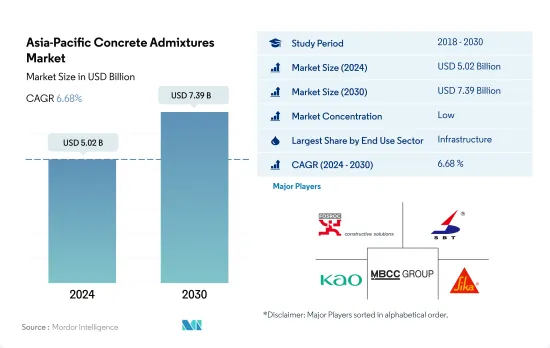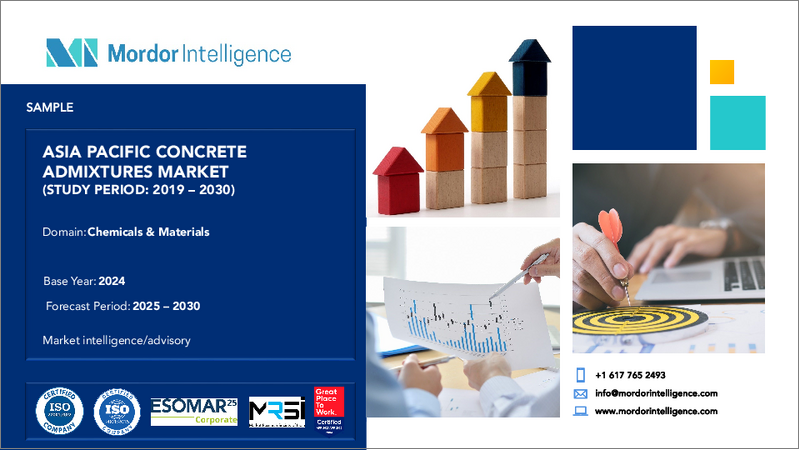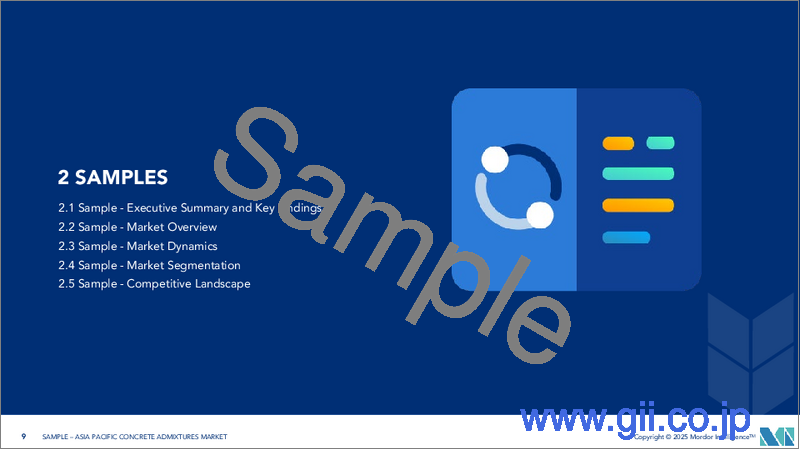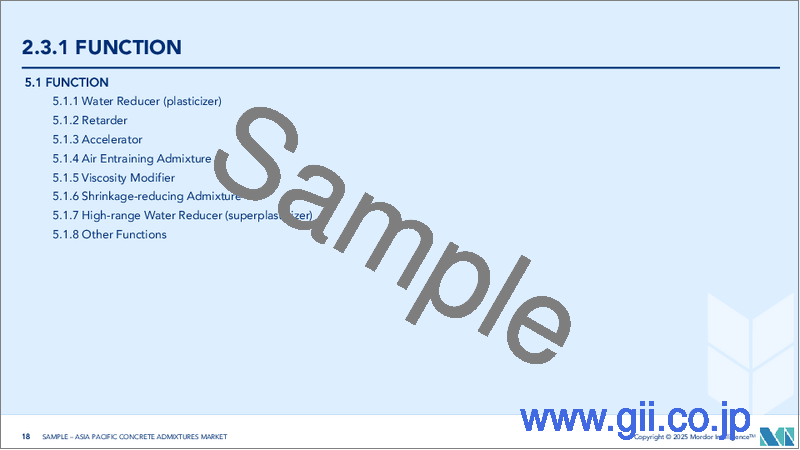|
|
市場調査レポート
商品コード
1683778
アジア太平洋地域のコンクリート混和剤:市場シェア分析、産業動向・統計、成長予測(2025年~2030年)Asia-Pacific Concrete Admixtures - Market Share Analysis, Industry Trends & Statistics, Growth Forecasts (2025 - 2030) |
||||||
カスタマイズ可能
適宜更新あり
|
|||||||
| アジア太平洋地域のコンクリート混和剤:市場シェア分析、産業動向・統計、成長予測(2025年~2030年) |
|
出版日: 2025年03月18日
発行: Mordor Intelligence
ページ情報: 英文 254 Pages
納期: 2~3営業日
|
全表示
- 概要
- 目次
アジア太平洋地域のコンクリート混和剤市場規模は2024年に50億2,000万米ドルと推定され、2030年には73億9,000万米ドルに達すると予測され、予測期間(2024~2030年)のCAGRは6.68%で成長する見込みです。

インフラ投資の増加がコンクリート混和剤需要を牽引する見込み
- アジア太平洋地域のコンクリート混和剤消費額は、インフラと住宅建設部門からの需要増加により、2023年には前年比5.35%の成長が見込まれます。2022年には、アジア太平洋地域のコンクリート混和剤は世界のコンクリート混和剤市場の約33%を占めていました。
- 同地域ではインフラ部門がコンクリート混和剤の最大の消費者であり、2022年には約35%を占めました。同地域ではインフラプロジェクトへの投資が増加しており、インフラ部門の需要を牽引すると予測されています。例えば、インドは2030年までにインフラ開発に約4兆5,000億米ドルを投資する意向です。同地域のインフラ支出は、2023年と比較して2030年には2,400億米ドル増加すると予測されています。その結果、同部門のコンクリート混和剤は2023年比で2030年に57.47%成長すると予測されます。
- 同地域の住宅部門はコンクリート混和剤の消費者として最も急成長しており、予測期間中のCAGRは7.84%と最も高いと予想されます。都市化の進展と政府の取り組みや国内外の投資による景気浮揚が、この地域の住宅需要を直接的・間接的に押し上げており、長期的には住宅建設が増加することになります。例えば、インドネシア政府(GOI)は2025年までに約100万戸の住宅建設を計画しており、同国の住宅需要は3,000万戸に達すると推定されています。その結果、この地域のコンクリート混和剤は、2023年の13億9,000万米ドルから2030年には23億6,000万米ドルに達すると予測されます。
インドネシアではメガ建設プロジェクトがあるため、コンクリート混和剤の需要が高まると予想されます。
- 減水剤、空気混入剤、遅延剤、促進剤、超可塑剤などのコンクリート混和剤は、混合前または混合中にコンクリートに添加され、その特性を変更します。2022年、アジア太平洋地域のコンクリート混和剤市場は、2021年と比較して金額で2.97%減少しました。中国のコンクリート混和剤はアジア太平洋地域諸国の中で最悪の打撃を受け、2021年から2022年にかけて金額で6.99%減少しました。これは、政府のCOVIDゼロ政策が新たなロックダウンを課し、建設プロジェクトを停止させたことに起因しています。これとは対照的に、オーストラリアのコンクリート混和剤市場は2021年から2022年にかけて金額で22.53%の最高成長を記録し、2022年から2023年にかけても同国のコンクリート混和剤市場は金額で7.54%の成長が見込まれることから、この成長は続くと予想されます。
- 中国のコンクリート混和剤市場は、2022年に金額ベースで67%の最大市場シェアを占めました。コンクリート混和剤の全最終用途分野の中で、インフラ建設のみが2021年から2022年にかけて金額で7.42%のプラス成長を記録したが、これは公共交通インフラへの支出が2021年の1,576億米ドルに対して2022年には1,656億米ドルに達したためです。
- インドネシアのコンクリート混和剤市場は、予測期間中に金額で7.06%と最も速いCAGRで推移すると推定されます。インドネシア政府は、建設セクターの成長を促進しコンクリート混和剤の利用を増加させるであろう数多くのメガ建設プロジェクトを発表しています。これには、2045年までに首都をジャカルタからボルネオ島に移転する320億米ドルの計画が含まれ、これには複数の住宅、製造施設、発電所、インフラなどの建設が含まれます。
アジア太平洋地域のコンクリート混和剤市場動向
インドなどで小売店やオフィススペースが増加し、アジア太平洋地域の商業建設セクターを押し上げる
- 2022年、アジア太平洋地域の商業施設の新設床面積は前年比3.23%減少しました。この後退は、規制の圧力、インフレ率の上昇、住宅ローン金利の急上昇といった要因によるものです。2023年には、この地域は回復し、商業施設の新設床面積は約1億4,600万平方フィート増加しました。この急増は主に外国直接投資(FDI)の増加によるもので、新しいオフィス、倉庫、小売店、その他の施設の需要に拍車をかけた。特に、ベトナムの建設部門は2023年に7,144万米ドルのFDI資本を誘致しました。
- 2020年、アジア太平洋地域は商業施設の新設床面積で大幅な後退を経験し、2019年比で21.92%の数量減となりました。この減少の主な原因は、政府による封鎖が広まり、プロジェクト作業が中断され、サプライチェーン、設備、労働力に深刻な影響を与えたことです。しかし、規制が緩和されるにつれ、同地域は目覚ましい回復を見せ、2021年の商業施設の新設床面積は20.98%急増し、約5億2,600万平方フィートの床面積に達しました。
- アジア太平洋地域の商業用新設床面積は大幅な成長が見込まれ、2023年と比較して2030年には14億1,000万平方フィート増加すると推定されます。この急増は、ショッピングモール、オフィススペース、小売店などに対する需要の高まりに後押しされています。アジア太平洋地域は世界の小売大国として台頭しており、世界の小売成長の4分の3近くに寄与しています。例えば、インドのグレードAオフィス市場は、上位7都市で2026年までに10億平方フィート、さらに2030年までに12億平方フィートまで拡大する可能性があります。全体として、アジア太平洋地域の商業施設の新設床面積は、予測期間中にCAGR5.16%を記録すると予測されています。
インドでは2030年までに2,500万戸に達する可能性があるなど、手頃な価格の住宅が増加し、同地域の住宅建設が拡大します。
- 2022年、アジア太平洋地域の住宅着工床面積は前年比約5.39%減少しました。この落ち込みは、COVID-19の大流行時に建築活動が急増した後、セクターが正常化した結果です。この地域の住宅セクターは、人口の増加、富裕層の増加、急速な都市化によって牽引されています。同地域の住宅新築床面積は、2023年には2022年比で4億1,000万平方フィート増加すると予想されました。
- 2020年、アジア太平洋地域の住宅新設床面積は2019年比で約5.06%減少しました。これは主に、政府による封鎖、サプライチェーンの混乱、労働力不足、建設生産性の低下、外国投資の低迷によるものでした。しかし、規制が緩和されるにつれて、この地域では大幅な回復が見られ、2021年には住宅新設戸数の増加により住宅新設床面積が約14億平方フィート急増しました。例えば、2021年だけでも、インドの住宅不動産市場は上位7都市で約16万3,000戸の新築住宅を導入します。
- アジア太平洋地域の住宅新築床面積は、予測期間中にCAGR 3.98%を記録すると予測されます。この成長は、住宅需要、投資の増加、有利な政府政策によるものです。より手頃な価格の住宅建設に注力することで、同地域の住宅建設セクターは活気を取り戻し、回復に向かうと予想されます。2030年までには、インド人口の40%以上が都市部に居住するようになると推定され、さらに2,500万戸の手頃な価格の住宅需要が見込まれます。この需要の急増により、インドの住宅用不動産市場は2030年までに150万戸に達すると予想されます。
アジア太平洋地域のコンクリート混和剤産業の概要
アジア太平洋地域のコンクリート混和剤市場は細分化されており、上位5社で29.49%を占めています。この市場の主要企業は以下の通り。 Fosroc, Inc., Jiangsu Subote New Material, Kao Corporation, MBCC Group and Sika AG(sorted alphabetically).
その他の特典
- エクセル形式の市場予測(ME)シート
- 3ヶ月のアナリストサポート
目次
第1章 エグゼクティブサマリーと主な調査結果
第2章 レポートのオファー
第3章 イントロダクション
- 調査の前提条件と市場定義
- 調査範囲
- 調査手法
第4章 主要産業動向
- 最終用途セクターの動向
- 商業
- 産業・施設
- インフラ
- 住宅
- 主要インフラプロジェクト(現在および発表済み)
- 規制の枠組み
- バリューチェーンと流通チャネル分析
第5章 市場セグメンテーション(市場規模、2030年までの予測、成長見通し分析を含む)
- 最終用途セクター
- 商業
- 産業・施設
- インフラ
- 住宅
- サブ製品
- 促進剤
- 空気混入混和剤
- 高範囲減水剤(超可塑剤)
- リターダー
- 収縮低減混和剤
- 粘度調整剤
- 減水剤(可塑剤)
- その他のタイプ
- 国
- オーストラリア
- 中国
- インド
- インドネシア
- 日本
- マレーシア
- 韓国
- タイ
- ベトナム
- その他アジア太平洋地域
第6章 競合情勢
- 主要な戦略動向
- 市場シェア分析
- 企業情勢
- 企業プロファイル
- Cementaid International Group of Companies
- Fosroc, Inc.
- Guangdong Redwall New Materials Co.,Ltd
- Jiangsu Subote New Material Co., Ltd.
- Kao Corporation
- MAPEI S.p.A.
- MBCC Group
- MC-Bauchemie
- Saint-Gobain
- Sika AG
第7章 CEOへの主な戦略的質問
第8章 付録
- 世界概要
- 概要
- ファイブフォース分析フレームワーク(産業魅力度分析)
- 世界のバリューチェーン分析
- 市場力学(DROs)
- 情報源と参考文献
- 図表一覧
- 主要洞察
- データパック
- 用語集
The Asia-Pacific Concrete Admixtures Market size is estimated at 5.02 billion USD in 2024, and is expected to reach 7.39 billion USD by 2030, growing at a CAGR of 6.68% during the forecast period (2024-2030).

The rise in infrastructure investment is expected to drive the demand for concrete admixtures
- The consumption value of concrete admixtures in Asia-Pacific was expected to witness a growth of 5.35% by value in 2023 compared to the previous year due to increasing demand from infrastructure and residential construction sectors. In 2022, Asia-Pacific's concrete admixtures accounted for around 33% of the global concrete admixtures market.
- The infrastructure sector is the region's largest consumer of concrete admixtures, which accounted for around 35% in 2022. The increase in investment for infrastructure projects in the region is projected to drive the demand for the infrastructure sector. For instance, India intends to invest around USD 4.5 trillion in infrastructure development by 2030. The infrastructure spending in the region is projected to increase by USD 240 billion in 2030 compared to 2023. As a result, the concrete admixtures for the sector are projected to grow by 57.47% in 2030 compared to 2023.
- The region's residential sector is expected to be the fastest-growing consumer of concrete admixtures, with the highest CAGR of 7.84% during the forecast period. The growing urbanization and economic boost from government initiatives and foreign and domestic investments are directly and indirectly pushing the region's housing needs, which would increase residential building construction in the long run. For instance, the Government of Indonesia (GOI) intends to construct around 1 million housing units by 2025, with the country's housing requirements estimated to reach 30 million units. As a result, the region's concrete admixtures for the sector are projected to reach USD 2.36 billion by 2030 from USD 1.39 billion in 2023.
The demand for concrete admixtures is expected to be high in Indonesia owing to the country's mega-construction projects
- Concrete admixtures, such as water reducers, air entrainers, retarders, accelerators, and superplasticizers, are added to concrete before or during mixing to modify its properties. In 2022, the Asia-Pacific concrete admixtures market declined by 2.97% in value compared to 2021. The concrete admixtures in China took the worst hit among all Asia-Pacific countries and fell by 6.99% in value from 2021 to 2022. This can be attributed to the government's zero COVID policy that imposed fresh lockdowns and halted construction projects. In contrast, the Australian concrete admixtures market recorded the highest growth of 22.53% in value from 2021 to 2022, which was expected to continue as the country's concrete admixtures market was expected to grow by 7.54% in value from 2022 to 2023.
- China's concrete admixtures market accounted for the largest market share of 67% by value in 2022. Among all end-use sectors for concrete admixtures, only infrastructure construction recorded a positive growth of 7.42% in value from 2021 to 2022, owing to the country's expenditure on public transport infrastructure, which reached USD 165.6 billion in 2022 compared to USD 157.6 billion in 2021.
- Indonesia's concrete admixtures market is estimated to register the fastest CAGR of 7.06% in value during the forecast period. The government of Indonesia has announced numerous mega-construction projects that will likely promote the growth of the construction sector and increase the utilization of concrete admixtures in the country. This includes the USD 32 billion plan to relocate the country's capital city from Jakarta to Borneo Island by 2045, which involves the construction of several residential units, manufacturing facilities, power plants, infrastructure, etc.
Asia-Pacific Concrete Admixtures Market Trends
Rising retail and office spaces in countries such as India to boost the Asia-Pacific commercial construction sector
- In 2022, Asia-Pacific witnessed a 3.23% decline in its commercial new floor area compared to the previous year. This setback was attributed to factors such as regulatory pressures, higher inflation, and a surge in mortgage rates. In 2023, the region rebounded, with commercial construction new floor area increasing by approximately 146 million sq. ft. This surge was primarily driven by a rise in foreign direct investment (FDI), which spurred the demand for new offices, warehouses, retail outlets, and other facilities. Notably, the Vietnamese construction sector attracted an FDI capital of USD 71.44 million in 2023.
- In 2020, the Asia-Pacific region experienced a significant setback in commercial new floor area, with a volume decline of 21.92% compared to 2019. This decline was primarily due to widespread government lockdowns, which disrupted project work and severely impacted supply chains, equipment, and labor. However, as restrictions eased, the region witnessed a remarkable rebound, with its commercial new floor area surging by 20.98% in 2021, reaching a volume of approximately 526 million sq. ft.
- Asia-Pacific's commercial new floor area is projected to witness substantial growth, with an estimated increase of 1.41 billion sq. ft by 2030 compared to 2023. This surge is fueled by a rising demand for shopping malls, office spaces, retail outlets, and more. The Asia-Pacific region is emerging as a global retail powerhouse, contributing to nearly three-quarters of the worldwide retail growth. For instance, the Indian Grade A office market in its top seven cities may to expand to 1 billion sq. ft by 2026 and further to 1.2 billion sq. ft. by 2030. Overall, the commercial new floor area in Asia-Pacific is projected to witness a volume CAGR of 5.16% during the forecast period.
Rising affordable housing units, such as India's likely to reach 25 million by 2030, to augment the residential constructions in the region
- In 2022, the residential new floor area in the Asia-Pacific region saw a volume decline of approximately 5.39% from the previous year. This dip was a result of the sector normalizing after a surge in building activity during the COVID-19 pandemic. The region's residential sector is driven by a growing population, increasing wealth, and rapid urbanization. The residential new floor area in the region was expected to rise by 410 million sq. ft in 2023 compared to 2022.
- In 2020, the residential new floor area in Asia-Pacific declined in volume by around 5.06% compared to 2019. This was primarily due to government-imposed lockdowns, disruptions in the supply chain, labor shortages, reduced construction productivity, and low foreign investments. However, as restrictions eased, the region saw a significant rebound, with the residential new floor area surging by about 1.4 billion sq. ft in 2021, driven by the addition of new residential housing units. For instance, in 2021 alone, the Indian residential real estate market introduced approximately 163 thousand new residential units across its top seven cities.
- The residential new floor area in the Asia-Pacific region is projected to witness a CAGR of 3.98% during the forecast period. This growth can be attributed to the demand for housing, increased investments, and favorable government policies. The focus on constructing more affordable housing units is expected to rejuvenate the residential construction sector in the region, aiding its recovery. By 2030, it is estimated that over 40% of India's population will reside in urban areas, leading to a demand for an additional 25 million affordable housing units. This surge in demand is expected to push the Indian residential real estate market to reach 1.5 million units by 2030.
Asia-Pacific Concrete Admixtures Industry Overview
The Asia-Pacific Concrete Admixtures Market is fragmented, with the top five companies occupying 29.49%. The major players in this market are Fosroc, Inc., Jiangsu Subote New Material Co., Ltd., Kao Corporation, MBCC Group and Sika AG (sorted alphabetically).
Additional Benefits:
- The market estimate (ME) sheet in Excel format
- 3 months of analyst support
TABLE OF CONTENTS
1 EXECUTIVE SUMMARY & KEY FINDINGS
2 REPORT OFFERS
3 INTRODUCTION
- 3.1 Study Assumptions & Market Definition
- 3.2 Scope of the Study
- 3.3 Research Methodology
4 KEY INDUSTRY TRENDS
- 4.1 End Use Sector Trends
- 4.1.1 Commercial
- 4.1.2 Industrial and Institutional
- 4.1.3 Infrastructure
- 4.1.4 Residential
- 4.2 Major Infrastructure Projects (current And Announced)
- 4.3 Regulatory Framework
- 4.4 Value Chain & Distribution Channel Analysis
5 MARKET SEGMENTATION (includes market size, forecasts up to 2030 and analysis of growth prospects.)
- 5.1 End Use Sector
- 5.1.1 Commercial
- 5.1.2 Industrial and Institutional
- 5.1.3 Infrastructure
- 5.1.4 Residential
- 5.2 Sub Product
- 5.2.1 Accelerator
- 5.2.2 Air Entraining Admixture
- 5.2.3 High Range Water Reducer (Super Plasticizer)
- 5.2.4 Retarder
- 5.2.5 Shrinkage Reducing Admixture
- 5.2.6 Viscosity Modifier
- 5.2.7 Water Reducer (Plasticizer)
- 5.2.8 Other Types
- 5.3 Country
- 5.3.1 Australia
- 5.3.2 China
- 5.3.3 India
- 5.3.4 Indonesia
- 5.3.5 Japan
- 5.3.6 Malaysia
- 5.3.7 South Korea
- 5.3.8 Thailand
- 5.3.9 Vietnam
- 5.3.10 Rest of Asia-Pacific
6 COMPETITIVE LANDSCAPE
- 6.1 Key Strategic Moves
- 6.2 Market Share Analysis
- 6.3 Company Landscape
- 6.4 Company Profiles
- 6.4.1 Cementaid International Group of Companies
- 6.4.2 Fosroc, Inc.
- 6.4.3 Guangdong Redwall New Materials Co.,Ltd
- 6.4.4 Jiangsu Subote New Material Co., Ltd.
- 6.4.5 Kao Corporation
- 6.4.6 MAPEI S.p.A.
- 6.4.7 MBCC Group
- 6.4.8 MC-Bauchemie
- 6.4.9 Saint-Gobain
- 6.4.10 Sika AG
7 KEY STRATEGIC QUESTIONS FOR CONCRETE, MORTARS AND CONSTRUCTION CHEMICALS CEOS
8 APPENDIX
- 8.1 Global Overview
- 8.1.1 Overview
- 8.1.2 Porter's Five Forces Framework (Industry Attractiveness Analysis)
- 8.1.3 Global Value Chain Analysis
- 8.1.4 Market Dynamics (DROs)
- 8.2 Sources & References
- 8.3 List of Tables & Figures
- 8.4 Primary Insights
- 8.5 Data Pack
- 8.6 Glossary of Terms





